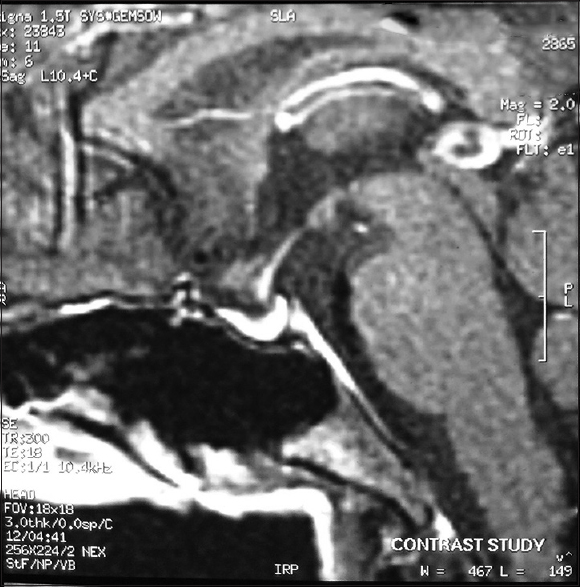Translate this page into:
Even very low dose hydrocortisone might precipitate psychosis in Sheehan's syndrome: A need for caution
Address for correspondence: Dr. Seshadri Sekhar Chatterjee, Department of Psychiatry, Medical College, Kolkata, West Bengal, India. E-mail: drsschatterjee@gmail.com
This is an open access article distributed under the terms of the Creative Commons Attribution NonCommercial ShareAlike 3.0 License, which allows others to remix, tweak, and build upon the work non commercially, as long as the author is credited and the new creations are licensed under the identical terms.
This article was originally published by Medknow Publications & Media Pvt Ltd and was migrated to Scientific Scholar after the change of Publisher.
Sir,
Panhypopituitarism, postpartum onset, and need for the external use of steroids – patients with Sheehan's syndrome (SS) have multiple reasons to be vulnerable to develop psychosis. Improvements in healthcare facilities have resulted in a decline in reports of SS from developed countries over last few decades though it continues to remain an important entity in developing countries.[12] In this letter, we report a case of SS in which the patient developed psychosis as a complication of this condition. Psychosis in this condition is seldom reported,[1] and hence we feel the need to report this with a biological explanation.
A 27-year-old female patient (para2 + 0), with nil contributory past or family history and with hitherto uncomplicated twin pregnancy, developed obstructed labor in the 28th week of her pregnancy. The first child was stillborn, and the patient developed postpartum hemorrhage (PPH). In order to save the other twin, emergency cesarean section was performed, and the 2nd twin was delivered alive. The PPH was surgically managed, with 2 units of whole blood transfusion.
After around 4 months of this delivery, the patient developed repeated nausea and vomiting, lactational failure, and severe weakness over 2 weeks' time. Suspecting this to be a complication of PPH, upon detailed history and physical examination, a hormonal assay was performed. The patient had low thyroid stimulating hormone and low serum cortisol levels. She was diagnosed as SS, and her magnetic resonance imaging (MRI) pituitary scan corroborated with the diagnosis showing “partially empty sella” [Figure 1]. The patient was started on hydrocortisone 30 mg in divided doses, based on the diagnosis of SS, along with thyroxin 25 µg. After 2 days on this regimen, she developed fearfulness, self-muttering, and emotional incontinence, all in clear consciousness and with full orientation to time, place, and person. The patient was managed with hypnotics (clonazepam 0.5 mg at night), but the psychiatric conditions further deteriorated over next 2 days as she started talking in overtly grandiose manner, with clearly expressed delusions of grandiosity and persecution, accelerated stream of thought, and easy distractibility. Her sleep was reduced, and care toward the child was deteriorating. The child was separated at this point from the mother, and she was started on risperidone 4 mg in two divided doses. Since hydrocortisone replacement was essential for SS, it was continued at a lower dose of 20 mg/day. Her psychotic symptoms attenuated within 7 days, and after 1-month risperidone was tapered down and stopped over 3 weeks. The patient maintained well at 2 months, with only hydrocortisone 20 mg/day and thyroxin 25 µg, from a psychiatric point of view. Her interaction with the child was also cordial.

- Magnetic resonance imaging showing partially empty sella
The diagnosis of SS is based on the history of PPH followed by complete anterior pituitary failure, with demonstration of empty sella on MRI pituitary scan.[2] Enlargement of pituitary gland occurs during pregnancy and PPH can result in ischemic necrosis of anterior pituitary resulting in hypopituitarism.[3] In our case, the patient had already developed subsyndromal psychotic symptoms at 2nd day postpartum, which got exacerbated into diagnosable entity with hydrocortisone. Psychosis in SS is a rarely-reported entity.[1] While the old school says hormone replacement therapy alone could control psychotic symptoms, sometimes antipsychotics might be needed as an adjunct, at least, during the initial phases of diagnosis.[4]
Our case demonstrates two interesting phenomenon. First, the reported minimum dose for steroid-induced psychosis is considered to be 40 mg prednisolone[5] or equivalent; which comes to around 120 mg of hydrocortisone;[6] incidences are increasing exponentially with increase in dosage. Hence, our patient developed psychosis at one-third of this dose. We, therefore, postulate the possibility of an increased sensitivity of neural glucocorticoid receptors to externally administered steroids, possibly generated by an acute dip in brain cortisol levels, and a reduction in negative feedback inhibition of G-protein coupled steroid auto-receptors; in patients with SS. With time, super-sensitivity reduced on regular steroid therapy, which allowed the discontinuation of risperidone. Second, since corticosteroid is a life-saving entity in SS, it had to be continued. This we did under the cover of an adequate dose of a potent antipsychotic and by reducing hydrocortisone to 20 mg/day.
Financial support and sponsorship
Nil.
Conflicts of interest
There are no conflicts of interest.
References
- Sheehan's syndrome presenting as psychosis: A rare clinical presentation. Med J Islam Repub Iran. 2013;27:35-7.
- [Google Scholar]
- Postpartum psychosis in a case of Sheehan's syndrome. Indian J Psychiatry. 1999;41:70-2.
- [Google Scholar]
- Mania in association with hydrocortisone replacement for Addison's disease. Postgrad Med J. 1992;68:41-3.
- [Google Scholar]
- Corticosteroid-related central nervous system side effects. J Pharmacol Pharmacother. 2013;4(Suppl 1):S94.
- [Google Scholar]
- Acute onset of steroid psychosis with very low dose of prednisolone in Sheehan's syndrome. Endocr J. 2006;53:255-8.
- [Google Scholar]





